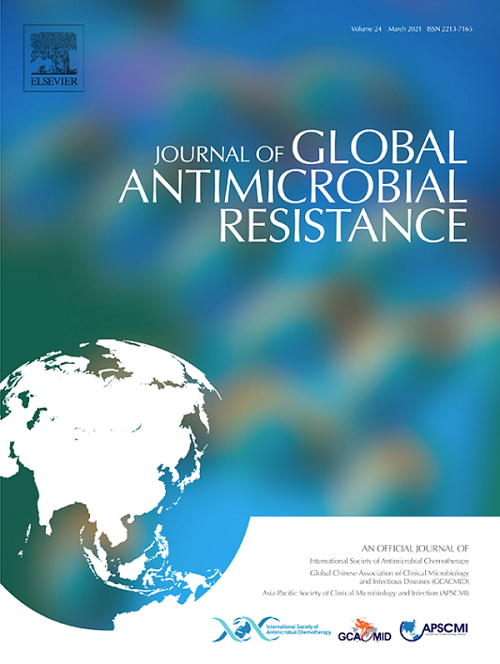Second-line drug resistance among multidrug-resistant tuberculosis patients in Ethiopia: A laboratory-based surveillance
IF 3.7
3区 医学
Q2 INFECTIOUS DISEASES
引用次数: 0
Abstract
Objectives
To estimate the proportion of second-line anti-tuberculosis drug resistance among multidrug-resistant tuberculosis (MDR-TB) patients in Ethiopia.
Methodology
A laboratory-based prospective cross-sectional study was conducted at the National Tuberculosis Reference Laboratory (NTRL), Ethiopia, from February 2022 to July 2024. Phenotypic drug susceptibility testing (pDST) assessed resistance to various second-line antituberculosis drugs. The collected data were entered into Microsoft Excel 2016 and imported into Statistical Package for Social Sciences (SPSS) version 23 for descriptive analysis.
Result
Of 468 MDR-TB patients, 262 were new, and 206 were previously treated cases. Pre-extensively drug-resistant tuberculosis (pre-XDR-TB) was identified in four (1.52%) new cases and seven (3.40%) previously treated cases. Extensively drug-resistant tuberculosis (XDR-TB) was detected in three (1.15%) new cases and two (0.97%) previously treated cases. Overall, 11 (2.35%) cases were classified as pre-XDR-TB, and five (1.07%) as XDR-TB. Combined resistance to fluoroquinolones (FQs) and bedaquiline were detected in four cases (0.85%), comprising three new cases (1.15%) and one previously treated case (0.49%). Resistance to both FQs and linezolid was detected in a single previously treated case (0.49%) and acquired resistance to second-line drugs was identified in four cases.
Conclusions
Our study showed a prevalence of 2.35% for pre-XDR-TB and 1.07% for XDR-TB among MDR-TB cases, highlighting the importance of continuous surveillance and tailored treatment approaches to control the spread of drug-resistant TB (DR-TB) in Ethiopia. Future studies on MDR-TB surveillance should prioritize the integration of genomic surveillance into routine laboratory-based DR-TB monitoring systems to enhance early detection of resistance patterns, support targeted treatment strategies, and improve overall patient management efforts.
埃塞俄比亚耐多药结核病患者的二线耐药性:基于实验室的监测。
目的:估计埃塞俄比亚耐多药结核病(MDR-TB)患者中二线抗结核药物耐药比例。方法:2022年2月至2024年7月,在埃塞俄比亚国家结核病参考实验室(NTRL)进行了一项基于实验室的前瞻性横断面研究。表型药敏试验(pDST)评估对各种二线抗结核药物的耐药性。将收集到的数据输入到Microsoft Excel 2016中,并导入SPSS (Statistical Package for Social Sciences) version 23进行描述性分析。结果:468例耐多药结核病患者中,新发病例262例,既往病例206例。在4例(1.52%)新发病例和7例(3.40%)既往治疗病例中发现广泛耐药前结核病(pre-XDR-TB)。在3例(1.15%)新发病例和2例(0.97%)既往治疗病例中发现广泛耐药结核病(XDR-TB)。总体而言,11例(2.35%)为前广泛耐药结核,5例(1.07%)为广泛耐药结核。氟喹诺酮类药物和贝达喹啉联合耐药4例(0.85%),其中新发3例(1.15%),既往治疗1例(0.49%)。1例既往治疗病例(0.49%)检测到对FQs和利奈唑胺均耐药,4例发现对二线药物获得性耐药。结论:我们的研究显示,在耐多药结核病病例中,前广泛耐药结核病的患病率为2.35%,广泛耐药结核病的患病率为1.07%,这突出了持续监测和定制治疗方法对控制耐药结核病(DR-TB)在埃塞俄比亚传播的重要性。未来的耐多药结核病监测研究应优先将基因组监测整合到常规的实验室耐多药结核病监测系统中,以加强耐药模式的早期发现,支持有针对性的治疗策略,并改善总体患者管理工作。
本文章由计算机程序翻译,如有差异,请以英文原文为准。
求助全文
约1分钟内获得全文
求助全文
来源期刊

Journal of global antimicrobial resistance
INFECTIOUS DISEASES-PHARMACOLOGY & PHARMACY
CiteScore
8.70
自引率
2.20%
发文量
285
审稿时长
34 weeks
期刊介绍:
The Journal of Global Antimicrobial Resistance (JGAR) is a quarterly online journal run by an international Editorial Board that focuses on the global spread of antibiotic-resistant microbes.
JGAR is a dedicated journal for all professionals working in research, health care, the environment and animal infection control, aiming to track the resistance threat worldwide and provides a single voice devoted to antimicrobial resistance (AMR).
Featuring peer-reviewed and up to date research articles, reviews, short notes and hot topics JGAR covers the key topics related to antibacterial, antiviral, antifungal and antiparasitic resistance.
 求助内容:
求助内容: 应助结果提醒方式:
应助结果提醒方式:


